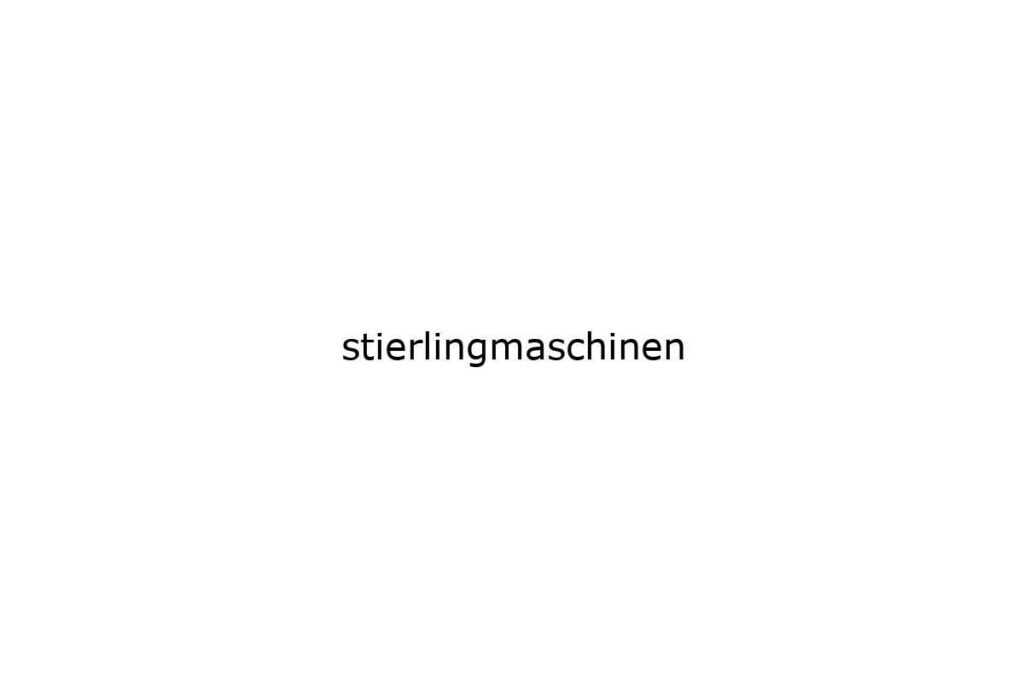When it comes to innovative energy solutions, Stierlingmaschinen stand out for their unique design and efficiency. I’ve always been fascinated by how these machines convert heat into mechanical energy, offering a glimpse into sustainable technology. Whether it’s for powering small devices or contributing to larger energy systems, Stierlingmaschinen have a wide range of applications that pique my interest.
In this article, I’ll dive into the principles behind Stierlingmaschinen, explore their advantages, and discuss their potential in today’s energy landscape. From their historical roots to modern advancements, understanding these engines reveals not just engineering marvels but also the promise of a greener future. Let’s explore the world of Stierlingmaschinen together and see how they can shape our approach to energy consumption.
Overview of Stierlingmaschinen
Stierlingmaschinen utilize an external heat source to induce motion through the expansion and contraction of gas. I find their design unique, as they operate on a closed-loop system with minimal emissions, showcasing remarkable efficiency.
Stierlingmaschinen consist of simple components, including a cylinder, displacer, and power piston. Each part plays a crucial role in converting thermal energy into mechanical energy. As the gas expands due to heat, it pushes the piston, generating power.
The efficiency of Stierlingmaschinen often reaches up to 40%, which surpasses traditional internal combustion engines. Their ability to operate on diverse heat sources, including solar energy and waste heat, enhances their versatility. Additionally, they operate quietly and can be optimized for various applications, from residential heating systems to vehicles.
Stierlingmaschinen also have historical significance. Invented in 1816 by Robert Stirling, they were initially designed for pumping water. Their development continued through the 19th and 20th centuries, gaining renewed interest in the 21st century due to advancements in materials and technology.
Modern iterations show promise in renewable energy applications. Research into improving their efficiency and durability continues to expand their potential in the sustainable energy landscape. I see great value in their contribution to reducing dependence on fossil fuels, paving the way for a more sustainable energy future.
How Stierlingmaschinen Work
Stierlingmaschinen, or Stierlingmaschinen, operate based on specific thermodynamic principles. They leverage temperature differences to generate mechanical energy efficiently.
Basic Principles
Stierlingmaschinen work through a closed-loop system where gas, such as air or helium, undergoes repeated cycles of heating and cooling. During the heating phase, the gas expands, pushing the power piston and producing work. In the cooling phase, the gas contracts, creating a vacuum that pulls the displacer back. This establishes a cycle that converts thermal energy into mechanical work. Operating at efficiencies of up to 40%, these engines utilize heat sources like solar energy and waste heat, making them viable for renewable energy solutions.
Key Components
Stierlingmaschinen consist of several essential components that facilitate their operation:
- Cylinder: The cylinder houses the gas, enabling it to expand and contract as it heats and cools.
- Displacer: The displacer moves the gas between the hot and cold regions within the cylinder, optimizing the engine’s efficiency.
- Power Piston: The power piston converts the expanded gas’s pressure into mechanical power, driving mechanical systems or generating electricity.
Together, these components work seamlessly to exploit the fundamental principles of thermodynamics, allowing Stierlingmaschinen to provide a clean and effective energy conversion solution.
Advantages of Stierlingmaschinen
Stierlingmaschinen deliver numerous benefits, making them a compelling choice for energy generation. Key advantages include energy efficiency and eco-friendliness.
Energy Efficiency
Stierlingmaschinen achieve high energy efficiency rates, often reaching up to 40%. This contrasts sharply with conventional internal combustion engines, typically operating at around 20% efficiency. The closed-loop system of Stierlingmaschinen allows them to harness heat from various sources, including solar power and waste heat. Their design maximizes the conversion of thermal energy into mechanical energy. For example, with proper temperature differentials, Stierlingmaschinen can operate at peak efficiency in a variety of applications, from small-scale devices to large power generation systems.
Eco-Friendliness
Stierlingmaschinen excel in eco-friendliness due to their minimal emissions. Operating on the principle of an external heat source, they produce significantly lower pollution levels compared to traditional combustion engines. These engines often use non-toxic gases, like helium or air, in their cycles. They also have the capability to utilize renewable energy sources effectively. By harnessing waste heat from industrial processes or utilizing solar energy, Stierlingmaschinen contribute to a reduced carbon footprint, promoting sustainable practices in energy generation. Overall, their environmentally conscious design supports goals for a cleaner energy future.
Applications of Stierlingmaschinen
Stierlingmaschinen demonstrate versatile applications across industries and recreation. Their unique characteristics make them suitable for energy conversion in various contexts.
Industrial Uses
Stierlingmaschinen serve diverse industrial applications, providing efficient energy solutions. Industries deploy them for:
- Cogeneration: Combining heat and power generation, Stierlingmaschinen enhance overall system efficiency, effectively utilizing excess heat.
- Renewable Energy: Solar thermal power plants often incorporate Stierlingmaschinen, efficiently converting solar energy into electricity with minimal emissions.
- Waste Heat Recovery: Many industries capture excess heat from processes, using Stierlingmaschinen to convert it into useful electrical energy, enhancing overall efficiency.
- Pumps and Compressors: Their quiet operation and high reliability make Stierlingmaschinen suitable for specific pumping and compressing tasks within industrial settings.
Recreational Uses
- Model Engines: Many enthusiasts build small Stirling engine models for educational and hobby purposes, illustrating fundamental engineering principles.
- Heating Systems: Some campers and outdoor enthusiasts utilize portable Stierlingmaschinen for heating, taking advantage of biomass and solar energy while minimizing environmental impacts.
- Remote Applications: Stierlingmaschinen provide power in off-grid locations, powering lights or small appliances for recreational vehicles and cabins, thanks to their efficiency and low emissions.
Conclusion
Stierlingmaschinen represent a remarkable fusion of efficiency and sustainability. Their ability to convert heat into mechanical energy with minimal emissions is truly impressive. I find it exciting to see how these engines can utilize various heat sources while providing a quiet operation.
As I delve deeper into their applications, it’s clear that Stierlingmaschinen are not just historical curiosities but vital players in our energy future. Their versatility across industries and recreational uses highlights their potential to drive innovation in renewable energy. Embracing this technology could lead us toward a more sustainable and eco-friendly world.
Frequently Asked Questions
What is a Stirling engine?
A Stirling engine is a type of heat engine that converts thermal energy into mechanical energy using a closed-loop system. It operates by heating and cooling gas to create motion, making it highly efficient and eco-friendly.
How does a Stirling engine work?
Stierlingmaschinen function by heating a gas, causing it to expand, and then cooling it, which makes it contract. This cycle drives a power piston, resulting in mechanical work. Key components include a cylinder, displacer, and power piston.
What are the benefits of Stierlingmaschinen?
Stierlingmaschinen are known for their high energy efficiency, reaching up to 40%, and producing significantly lower emissions compared to traditional engines. They can utilize various heat sources, including renewable ones, making them environmentally friendly.
Where are Stierlingmaschinen used?
Stierlingmaschinen are versatile and used across various applications, from residential heating and industrial cogeneration to portable models for camping. They excel in renewable energy systems and waste heat recovery due to their reliable and quiet operation.
Who invented the Stirling engine?
The Stirling engine was invented in 1816 by Robert Stirling. It has evolved significantly since then, gaining renewed interest in recent years due to advancements in materials and technology aimed at improving efficiency and sustainability.
What is the efficiency of Stierlingmaschinen compared to internal combustion engines?
Stierlingmaschinen are much more efficient than traditional internal combustion engines, achieving efficiencies up to 40%. In comparison, internal combustion engines typically operate at around 20% efficiency, making Stierlingmaschinen a superior choice for energy conversion.


